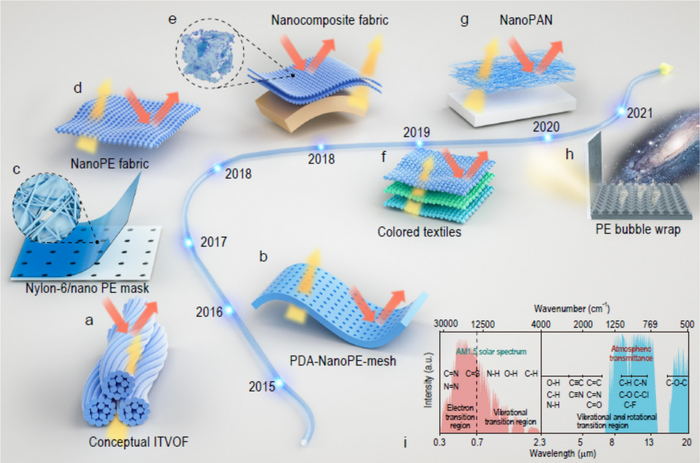Reviewed by Emily Henderson, B.Sc.Nov 3 2022
The common challenges that humans face are due to the increasing global warming and extreme weather. This directly impacts the health of individuals and even poses severe threats to lives.

(a) Theoretical framework to design IR-transparent fabric. (b) Schematic of polydopamine and nano-porous polyethylene (PDA-NanoPE-mesh) with performance comparable with that of cotton. (c) Diagram of face masks with electrospun nylon-6 nanofibers on needle-punched nanoPE substrate. (d) Schematic of nanoPE fabric with high mid-IR transparency, visible opacity, and good wearability. (e) ZnO NPs embedded nano-porous PE fabric. (f) Schematic for the coloration of radiative cooling textiles, which is made by mixing IR-transparent inorganic pigment nanoparticles with PE. (g) Direct radiative cooling using IR-selective transparent covers. (h) Schematic of highly IR-transparent PE bubble warp to block ambient convective heat transfer and ensure the radiative heat transport from objects to outer space. (i) The selection of functional groups for high emittance and low solar absorption. Image Credit: Science China Press
In space-cooling, heating ventilation, thermal comfort, and air-conditioning systems that need considerable supply are utilized extensively. This leads to a surplus consumption of fossil fuels and major greenhouse gas emissions like CO2.
Enormous greenhouse gas emissions have caused an increase in climatic anomalies and global temperature. This considerably threatens the presence of life on Earth. Therefore, a new cooling strategy is immediately required to save energy and decrease emissions to safeguard the living environment and obtain carbon neutrality visions.
But few renewable energy sources are restricted by complicated systems and environmental, geographical, and stability problems. Hence, in response to global carbon neutrality and global warming, there is an urgent requirement for new cooling technologies in tenable carbon-neutral models to tackle the issue of superheating as an effective plan against the energy challenge.
To deal with such difficulties, in recent times, the research team headed by Professor Guangming Tao (Wuhan National Laboratory for Optoelectronics and Optics Valley Laboratory, Huazhong University of Science and Technology) and Professor Cheng-Wei Qiu (Department of Electrical and Computer Engineering, National University of Singapore) has suggested a possible radiative cooling paradigm depending on structural and material design, and new chances for sustainable carbon neutrality as an ecologically friendly, zero-energy, cooling strategy have also been provided.
This technology utilizes broad-spectrum selective and accurate regulation to fulfill the cooling requirements of multiple scenes via targeted optimization of optical structures, eventually attaining viable passive radiative cooling. Soon after being reported, this article had already been quoted in Wikipedia under the terms “Carbon neutrality” and “Passive daytime radiative cooling.”
For effective cooling to be achieved, conventional indoor cooling techniques use huge amounts of energy. Hence, depending on mid-infrared high-transmission radiation cooling, Chen, Cui, and Lenert et al. came up with wearable cooling devices to achieve passive and efficient indoor cooling by reflecting visible light as well as emitting heat radiation via the human body to the surrounding environment.
But passive cooling for hot outdoor surroundings is still considered a serious problem.
In outdoor environments, strong solar radiation is known to be another significant factor that increases the temperature of objects besides thermal radiation.
Hence, Fan and Zhu et al. achieved a passive cooling function by developing radiative cooling devices to modulate solar and mid-infrared radiation accurately. However, it is hard to achieve affordable and mass fabrication.
Yang, Zhu, and Tao et al. initiated randomly distributed micro- and nanoscale scatterers for viable and efficient outdoor passive cooling while being fabricated on a large scale. Researchers have developed a thin film, cooling wood, coating, metafabric, and other devices to achieve energy savings of 7% to 45% utilizing stable and sustainable passive cooling recipes.
It has been fixed that peak CO2 emissions and following carbon neutrality are predominant global difficulties for future societal development.
Furthermore, this review argues the future application scenarios of radiative cooling in the context of sustainable carbon neutrality strategies for passive and effective space cooling requirements and presents the development trends, technical challenges, and possible solutions for radiative cooling in the setting of current research.
The technology contracts to be employed in all views of daily life and extreme environments. This seems a highly effective strategy for retarding global warming and remodeling the global energy landscape.
Journal Reference:
Liang, J. et al. (2022) Radiative cooling for passive thermal management towards sustainable carbon neutrality. National Science Review. https://doi.org/10.1093/nsr/nwac208.